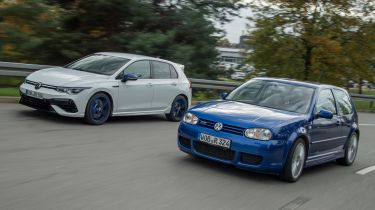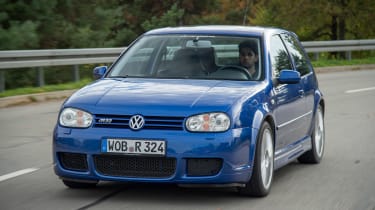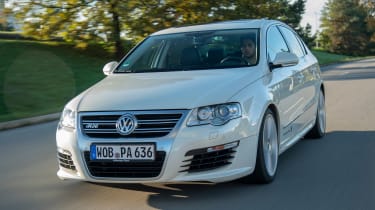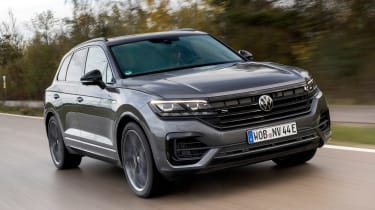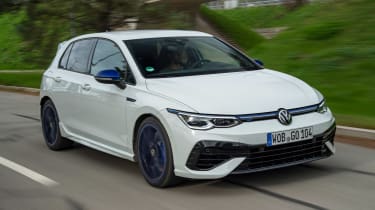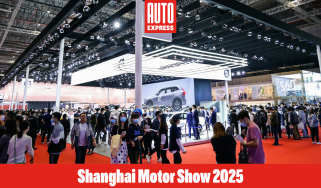Volkswagen R cars: history, brand ethos and the best models driven
We mark two decades of VW’s performance sub-brand by driving some of the models that have worn the blue R since it all started with the Golf R32 back in 2002
Since the Mk4 Golf R32 bullied its way into the hot-hatch realm in 2002, Volkswagen R models have defined themselves as formidably quick, indomitable machines that summon sweat on the brows of sports car owners. Their potency is indicated not with rippling, swollen bodywork and exterior trinkets, but by subtle stance and muted menace; crushing performance is never more than just a flick of a paddle away.
This blend of calm and fury has persistent appeal, but today, the performance sub-brand is at a crossroads. The Mk4 R32 arrived two decades ago, and to celebrate the occasion, Volkswagen has given us the new, 328bhp Golf R 20 Years. It’s the fastest, most powerful iteration yet, but it could mark the end of an era.
The firm’s EA888 turbocharged motor will be pushed no further beyond the 20 Years, and by 2030, the R brand will become EV-only. So, we decided to sample some of its iconic models.
Volkswagen Golf R32
Storming along a demanding, rain-soaked mountain pass, the wipers furiously batting away as the front wheels cut through puddles, tugging the steering wheel to remind us of the sodden surface beneath; a traditional sports car would be a cocktail of nervous inputs and floundering wheelspin along these roads, but not the Golf R32.
The original R32 set out the formula which the rest followed. Even with the recent onslaught of hulking, four-wheel-drive mega-hatches, the spec sheet reads just as favourably as it did 20 years ago, with a narrow-angle 3.2-litre V6, DSG gearbox and a Haldex four-wheel drive system delivering power to the road.
Of course, the R32 is characterised by its engine. It’s a hefty unit slung over the front axle, but the 15-degree V6 cleverly uses a single cylinder head, and it’s not short on grunt. Its 237bhp output hits surprisingly hard against the R32’s 1,510kg mass, and at high revs, the way it instinctively picks up is a delight.
There’s a smooth, linear intensity to the performance, and while it never reaches a scintillating crescendo, the cultured bellow as the revs rise is a sure-fire indication of six, rather than four, cylinders. The DSG gearbox is very responsive, too – despite the occasional lurching downshift – with a crisp shift action from the aluminium paddles.
Aim the blunt nose at some corners and the R32 can’t shake its slightly ponderous, heavy-handed feel, but it’s effortlessly fast. The gloopy steering gets lighter as you gather pace, but its responses are indistinct and wayward around the straight ahead, and it only gives feedback at the extremes of grip. But even in the wet, these limits aren’t easily breached; you can take liberties with the R32, thanks to its supreme traction and measured responses.
The R32 feels more experimental than later versions. The bucket seats appear to have been lifted from a motorsport catalogue and the 4WD system feels more rudimentary. The touring car-esque styling, howling engine and honest feel make it easily the most characterful of the bunch.
Volkswagen Passat R36
The R recipe has never struck quite the same chord in VW’s saloons as it has in the Golf. Perhaps four-wheel drive and colossal power in a humble hatch is a more intriguing idea than in the well established genre of fast saloons.
But the Passat R36 is no ordinary take on the theme. Alongside modern, small-capacity turbo engines, the R36’s gutsy, sonorous 3.6-litre V6 is a gem, and the modest, largely unmodified Passat bodyshell is wonderfully incongruous.
It’s tempting to drive the R36 with the verve of the R32, but despite its similar mechanical spec, the Passat doesn’t like to be rushed. In pure acceleration terms, the 296bhp R36 will put daylight between itself and the Golf, but the slow steering and 1,747kg kerbweight soften its reactions.
The brakes don’t bite with reassurance, either, and the rubbery imprecision to the controls leaves you driving on approximation rather than feel. This is no BMW M3 rival, but in reality, that hardly matters.
Dial back the speed, and the Passat is a pleasant companion on the road, surfing along with its unstressed engine, quiet cabin and heavy-set feel. The serenity can unravel when pootling around in town, where the R36 bobs around on its springs and thumps into road imperfections, but the ride calms at the German autobahn speeds at which it feels, and indeed, was, intended.
The deep, bear-hugging seats are a triumph – better than in any modern Volkswagen, in fact – and with a turned metal dashboard and bespoke aluminium pedals, there’s just enough indication that this is a 155mph Passat. One, we suspect, that could romp to even higher speeds without an electronic limiter.
The cavernous, well appointed cabin – including cruise control and heated rear seats – cements the R36 as an alluring everyday brute.
Volkswagen Scirocco R
The coupé-esque hatch is immediately out of step with its relatives on the road. Suddenly, this isn’t a car that masks clumsy inputs, with the front tyres skating over damp roads under power as the motor strikes the red line.
Naturally, with a lower centre of gravity than its upright hatchback counterparts, the Scirocco R is more immediate, but it relays far more chatter from the road surface through the structure. In the firmer of the two damper modes, it feels busy and uncompromising, hugging the contours of the road and jolting over scarred surfaces, but the Scirocco taps into more of its suspension travel in Comfort mode.
Still, it feels more ragged than its peers on greasy tarmac, and it’s all the more entertaining because of it. The steering has a heft and directness which feel almost old-school when you’re leaning hard on the chassis, relinquishing weight when the front tyres slip under greedy throttle applications. In fact, the muscle it requires can sometimes feel obstructive, but the Scirocco R demands more of the driver than any other R product.
Push through the initial wheelspin with a measured right foot, and the Scirocco R is genuinely rapid. The 276bhp 2.0-litre motor is effervescent in the mid-range, and with the turbocharger on song, its responses are honest and transparent. As ever, the DSG gearbox cracks through the ratios obediently, although it’s a shame that the paddles themselves are puny, plastic items.
The dark, gloomy cabin isn’t particularly versatile, either, and tall adults will struggle for headroom in the rear seats. However, that’s the price you pay for what is arguably the best-looking R model of them all.
Volkswagen Touareg R
Any notions that the Touareg might drive like a supersized Golf R are decimated within the first mile or so. This is an altogether different kind of R, one that’s never truly at ease with its identity; the high-performance treatment confuses what is otherwise a well mannered, restrained package.
In its calmer driving modes, the Touareg’s air suspension is absorbent and plush over all but the most punishing tarmac, where it can’t quite keep control of its enormous 22-inch alloys. Even so, the 3.0-litre V6 plug-in hybrid powertrain makes this the first-ever electrified R, and sailing along in pure-electric mode makes the 2,533kg Touareg easily the most serene vehicle to wear the badge. It’s by far the heaviest, too.
The cabin is well isolated from wind and road noise, despite the car’s imposing frontal area, but the move towards screen-based interfaces has robbed it of the opulent feel of older versions. Swathes of fingerprint-attracting piano black plastic further detract from the unimaginative dash, which is dominated by a mammoth 15-inch touchscreen. A flash of blue on the steering wheel is a reminder of the hot SUV’s DNA, but it still feels more R-Line than purebred R.
Sport mode awakens the petrol engine for the full 456bhp, and as the Volkswagen plants its considerable mass on the rear tyres and lunges forward, there’s no doubting its 5.1-second 0-62mph time. It accrues speed effortlessly, and the torque from the e-motor is omnipresent, covering for the V6 under light loads. However, pitched high up and without an evocative backing track (the motor offers very little aural drama), the Touareg doesn’t encourage you to extend its powertrain, and shedding momentum isn’t particularly intuitive with regeneration-supported braking.
While the steering is accurate, peeling back the layers unearths the inherent compromises. The chassis feels remote as the tyres succumb to cornering loads, settling into mild understeer under power, despite the 4WD system sending up to 80 per cent of torque to the rear axle. You can manhandle the beefy 4x4 into line, but it feels inappropriate for a car of this size and weight, and the R moniker raises expectations beyond the Touareg’s tempered attitude.
Volkswagen Golf R 20 Years
As a measure of progress, jumping into the new Golf R 20 Years after a stint in the R32 is eye-opening. What felt like a brawny, all-weather missile in isolation is rendered limp, stodgy and undercooked by the latest version, which is no surprise given the two decades of development between the pair. The original has a charming powerplant and communicates its limits more clearly, but on the road, the R 20 Years is rarely going fast enough to reach them.
Even with bespoke badging and optional blue wheels, the 20 Years continues to disguise its performance potential, and the cabin is equally restrained. Carbon-fibre trim inserts are the only clue to the celebratory model, and despite some ergonomic oddities, such as unlit temperature and volume controls, the interior feels premium and purposeful.
Volkswagen has teased 328bhp from the special edition’s engine to produce the most powerful road-going Golf ever, and the result is suitably ballistic. It feels muscular and urgent throughout the rev band, the seven-speed DSG gearbox hitting each ratio home with a thump.
There’s tangible extra venom to the delivery over the standard Mk8 Golf R, but the difference isn’t transformative. What’s more noteworthy is a new turbo calibration, which keeps the throttle valve open to maintain boost under partial loads. Carrying pace in the wet, the reactive pick-up allows you to work the chassis with more fidelity, particularly when activating the R’s torque-vectoring rear differential.
The Golf’s 1,555kg mass doesn’t feel entirely keyed in during sharp direction changes, though, and the Mk8 is still missing the final degree of finesse to challenge the world’s greatest hot hatches. Setting the dampers to Sport or Race introduces a persistent fidget over bumps. Comfort dials some of this out, but it never perfectly gels with the road surface. Yet presented with a challenging road, the 20 Years draws you into a relentless rhythm. You drive the R32 with your shoulders, making deliberate inputs and jockeying the car through turns. By comparison, the 20 Years darts from corner to corner with flicks of the wrist, connecting them with bursts of power.
The tweaks certainly ramp up the drama, but the Golf R hasn’t been remoulded in 20 Years form. It remains a mighty performer, but for the extra £5,400 outlay, the special edition could have introduced a more tactile, fluid chassis to go with the extra power. Still, two decades later, the hottest Golf is not to be messed with.
Click here for our list of the best hot hatchbacks on sale....
Find a car with the experts

